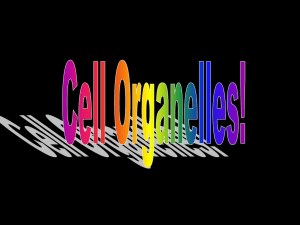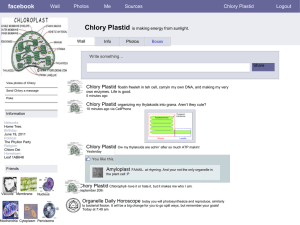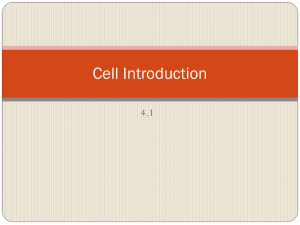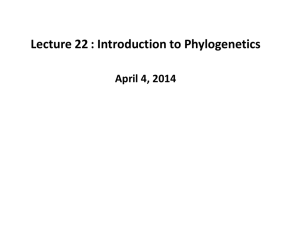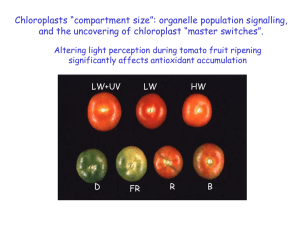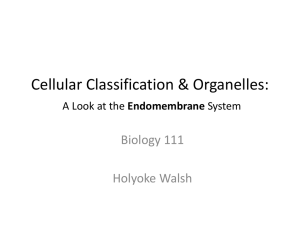1 Modeling Endosymbiosis Name Section Overall goal – to visualize
advertisement
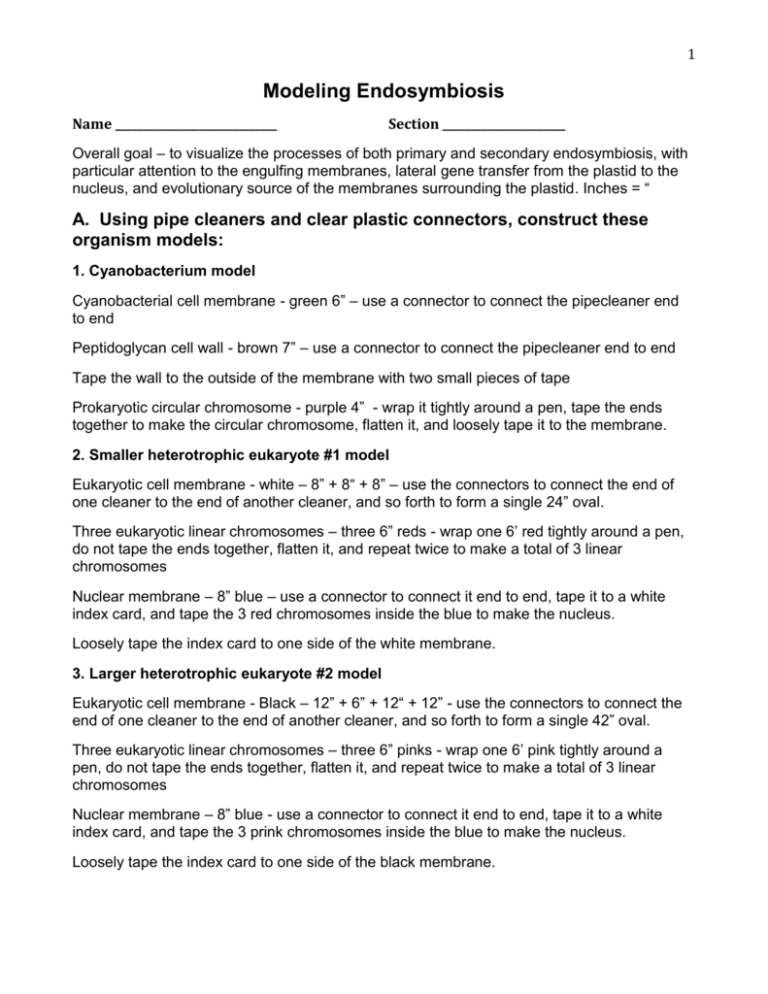
1 Modeling Endosymbiosis Name _____________________________ Section ______________________ Overall goal – to visualize the processes of both primary and secondary endosymbiosis, with particular attention to the engulfing membranes, lateral gene transfer from the plastid to the nucleus, and evolutionary source of the membranes surrounding the plastid. Inches = “ A. Using pipe cleaners and clear plastic connectors, construct these organism models: 1. Cyanobacterium model Cyanobacterial cell membrane - green 6” – use a connector to connect the pipecleaner end to end Peptidoglycan cell wall - brown 7” – use a connector to connect the pipecleaner end to end Tape the wall to the outside of the membrane with two small pieces of tape Prokaryotic circular chromosome - purple 4” - wrap it tightly around a pen, tape the ends together to make the circular chromosome, flatten it, and loosely tape it to the membrane. 2. Smaller heterotrophic eukaryote #1 model Eukaryotic cell membrane - white – 8” + 8“ + 8” – use the connectors to connect the end of one cleaner to the end of another cleaner, and so forth to form a single 24” oval. Three eukaryotic linear chromosomes – three 6” reds - wrap one 6’ red tightly around a pen, do not tape the ends together, flatten it, and repeat twice to make a total of 3 linear chromosomes Nuclear membrane – 8” blue – use a connector to connect it end to end, tape it to a white index card, and tape the 3 red chromosomes inside the blue to make the nucleus. Loosely tape the index card to one side of the white membrane. 3. Larger heterotrophic eukaryote #2 model Eukaryotic cell membrane - Black – 12” + 6” + 12“ + 12” - use the connectors to connect the end of one cleaner to the end of another cleaner, and so forth to form a single 42” oval. Three eukaryotic linear chromosomes – three 6” pinks - wrap one 6’ pink tightly around a pen, do not tape the ends together, flatten it, and repeat twice to make a total of 3 linear chromosomes Nuclear membrane – 8” blue - use a connector to connect it end to end, tape it to a white index card, and tape the 3 prink chromosomes inside the blue to make the nucleus. Loosely tape the index card to one side of the black membrane. 2 B. Primary endosymbiosis in action Evolutionary step 1 - How was the cyanobacterium taken up by the heterotrophic eukaryote #! to form the plastid (chloroplast = green plastid)? Use your models of a cyanobacterium and a smaller eukaryote #1 to recreate this process. The basic idea is to modify the models so that you create a model of a photosynthetic eukaryote containing a primary plastid. In theory, there are several different ways for a eukaryotic cell to fuse with a cyanobacterium. Hint: pay particular attention to figuring out the sources of the two membranes surrounding the primary plastid. Draw the resulting photosynthetic eukaryote, and label the sources of all the membranes and walls Evolutionary step 2 – the transformation of the cyanobacterium into a primary plastid: Lateral gene transfer from the cyanobacterial chromosome to the eukaryotic chromosome. A. Remove the cyanobacterial chromosome, cut off 10% of the chromosome, tape the ends of this small piece together, and finally tape this chromosome back inside the original cyanobacterium. B. Cut the remaining 90% of the chromosome into smaller pieces, and tape those pieces to various sites on linear eukaryotic chromosomes to model the process of lateral gene transfer. All plastids in modern algae have undergone this lateral gene transfer so that we can not use this trait for making predictions about the common ancestor of all photosynthetic eukaryotes. Evolutionary step 3 – the transformation of the cyanobacterium into a primary plastid: Loss of the peptidoglycan cell wall. Remove the brown cell wall and tape together the cyanobacterial cell membrane and the eukaryotic engulfing membrane to create the double membrane structure of a primary plastid. (A green plastid is called a chloroplast.) On the tope of the next page, make a labeled drawing of this primary plastid, including inner plastid membrane ( = original cyanobacterial membrane), outer plastid membrane ( = engulfing eukaryote #1 membrane) and reduced plastid chromosome 3 Brief class discussion: What groups show this stage of primary endosymbiosis? Mark this stage on the cladogram on the last page of this worksheet. C. Secondary endosymbiosis in action Evolutionary step 1 – How was a photosynthetic eukaryote (eukaryote #1 including its primary plastid) taken up by a larger heterotrophic eukaryote #2 to form the secondary plastid? Use your models of the photosynthetic eukaryote #1 and the larger eukaryote #2 to recreate this process. The basic idea is to modify the models so that you create a model of a photosynthetic eukaryote containing the secondary plastid. Hint: pay particular attention to figuring out the sources of the four membranes surrounding the secondary plastid. Draw the resulting photosynthetic eukaryote, and label the sources of all the membranes around the plastid and the cells. Use the following labels: inner plastid membrane ( = original cyanobacterial membrane) outer plastid membrane ( = engulfing eukaryote #1 membrane); eukaryote #1 nucleus eukaryote #1 outer membrane engulfing eukaryote #2 membrane (around eukaryote #1 outer membrane) eukaryote #2 nucleus eukaryote #2 outer membrane 4 Evolutionary step 2 . Transformation of the photosynthetic eukaryote #1 into a secondary plastid: Lateral gene transfer from the nucleus of the photosynthetic eukaryote to the nucleus of the heterotrophic eukaryote #2. Cut up the linear chromosomes of the photosynthetic eukaryote, and leave a few small pieces in the reduced nucleus of eukaryote #1, and tape most of the small pieces of both bacterial and eukaryotic genes to the chromosomes in the eukaryote #2 nucleus to model the process of lateral gene transfer. The genes in the nucleus of this eukaryote are thus derived from three different genomes. The original eukaryote #1 is now referred to as a secondary plastid, and the reduced nucleus in the original eukaryote #1 is called a nucleomorph Label the membranes in this secondary plastid and the nucleomorph in the drawing below Brief class discussion: Several small algal groups group show this stage of secondary endosymbiosis with a nucleomorph, but they are not included in our cladogram. Evolutionary Step 3. Transformation of the photosynthetic eukaryote into a secondary plastid: Complete lateral gene transfer from the nucleomorph in the secondary plastid into the nucleus of the heterotrophic eukaryote #2. Transfer all remaining genes from the nucleomorph to the nucleus of the large eukaryote. Remove the nuclear membrane of the nucleomorph from the model. Evolutionary Step 4. Transformation of the photosynthetic eukaryote into a secondary plastid: Four membranes around secondary plastid. Reduce the length of outer membranes surrounding the secondary plastid, and use the connectors to connect them endto-end to form the typical four-membrane envelope around secondary plastids. Now make a 5 labeled drawing of this stage in secondary endosymbiosis. Indicate the source of all membranes surrounding the secondary plastid in this drawing. Brief class discussion: What groups show this stage of secondary endosymbiosis? Mark these stages on the cladogram on the last page of this worksheet. 6 Current Hypotheses in Plastid Endosymbiosis 7
